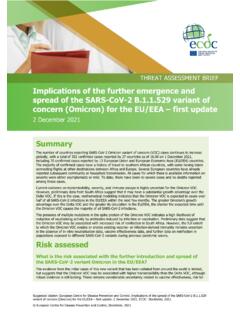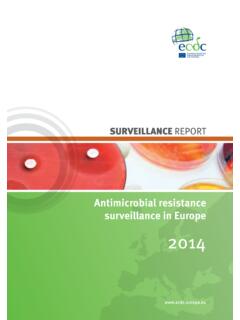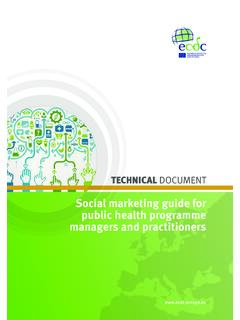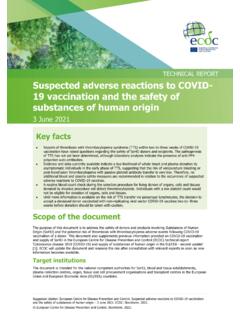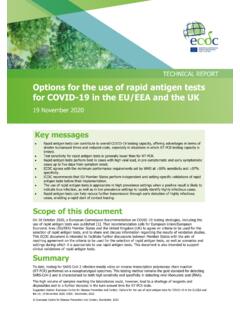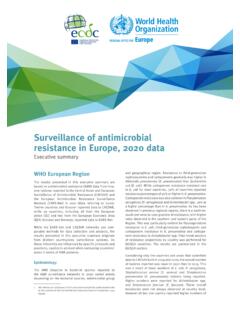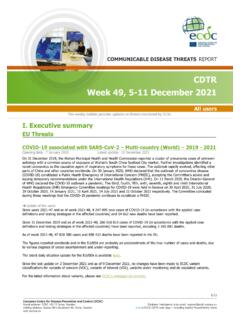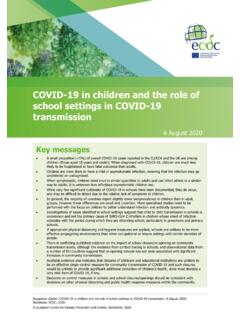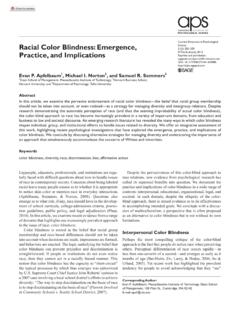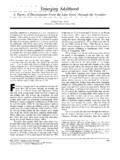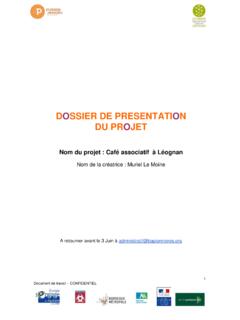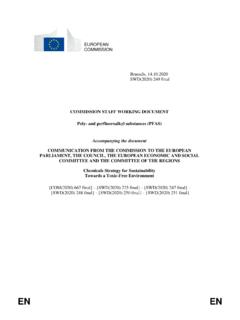Transcription of Implications of the emergence and spread of the SARS-CoV …
1 Suggested citation: European Centre for Disease Prevention and Control. Implications of the emergence and spread of the SARS-CoV -2 529 variant of concern (Omicron), for the EU/EEA. 26 November 2021. ECDC: Stockholm; 2021. European Centre for Disease Prevention and Control, Stockholm, 2021 THREAT ASSESSMENT BRIEF Implications of the emergence and spread of the SARS-CoV -2 529 variant of concern (Omicron) for the EU/EEA 26 November 2021 Summary A SARS-CoV -2 variant belonging to Pango lineage , with a high number of S-gene mutations compared to the original virus was detected at the beginning of November 2021. On 26 November 2021 the variant was designated a variant of concern (VOC) and assigned the label Omicron by the World Health Organization (WHO). The variant is characterised by 30 changes, three small deletions and one small insertion in the spike protein, of these, 15 are in the receptor binding domain.
2 This variant was first detected in samples collected on 11 November 2021 in Botswana and on 14 November 2021 in South Africa. As of 26 November 2021, travel-related cases have also been detected in Belgium, Hong Kong and Israel. The Omicron variant is the most divergent variant that has been detected in significant numbers during the pandemic so far, which raises concerns that it may be associated with increased transmissibility, significant reduction in vaccine effectiveness and increased risk for reinfections. As of 26 November 2021, ECDC has classified this variant as a variant of concern (VOC) due to concerns regarding immune escape and potentially increased transmissibility compared to the Delta variant. Risk assessed What is the risk associated with the introduction and possible community spread of the SARS-CoV -2 variant Omicron in the EU/EEA?
3 There is considerable uncertainty related to the transmissibility, vaccine effectiveness, risk for reinfections and other properties of the Omicron variant. However, given its immune escape potential and potentially increased transmissibility advantage compared to Delta, we assess the probability of further introduction and community spread in the EU/EEA as HIGH. In a situation where the Delta variant is resurgent in the EU/EEA, the impact of the introduction and possible further spread of Omicron could be VERY HIGH. In conclusion, the overall level of risk for the EU/EEA associated with the SARS-CoV -2 variant Omicron is assessed as HIGH to VERY HIGH. Options for response Based on the mutation profile of Omicron, partial immune escape is likely. Due to the uncertainties concerning Omicron immune escape properties, a precautionary approach is important and the timely and urgently reinforced implementation of non-pharmaceutical interventions (NPIs) in the EU/EEA is strongly advised.
4 THREAT ASSESSMENT BRIEF Implications for the EU/EEA on the emergence and spread of the SARS-CoV -2 variant 2 Event background As of 26 November 2021, ECDC has classified a SARS-CoV -2 variant belonging to Pango lineage as a variant of concern (VOC) due to concerns regarding immune escape and potentially increased transmissibility compared to the Delta variant. WHO classified the variant as a VOC and assigned it the label Omicron. The novel SARS-CoV -2 variant Omicron was first detected in samples collected on 11 November 2021 in Botswana, and subsequently in samples collected from 14 November and onward in South Africa. One case has been detected in Hong Kong with travel history to South Africa, collection date 18 November 2021. As of 26 November 2021, sequences of the variant Omicron have been reported from Botswana [1], South Africa [2], Israel [3],Hong Kong [4] and Belgium [5].
5 All available sequences are deposited in GISAID EpiCoV [6]. Official sources in Hong Kong state that there is a cluster of two travel-related cases of Omicron [4]. Official sources in Israel report one case in a traveller returning from Malawi, and two suspected cases in other returning travellers are being investigated [3]. The Belgium Minister of Health stated that a case in an unvaccinated traveller has been detected [5]. Botswana confirmed four cases of the Omicron variant in an official press release, stating that they were all fully vaccinated and detected in pre-travel screening [1]. Investigations in South Africa using S-gene target failure (SGTF) of the PCR assays as a proxy for the variant have shown that there is a very sharp increase in incidence across most provinces since mid-November, with the most pronounced increase in the Gauteng province, where SGTF is observed for more than 50% of all tested specimens in the last few days.
6 Sequencing of 77 selected SGTF samples from Gauteng collected between 12 and 20 November 2021 confirmed all of them as Omicron. These findings presented in a press conference held by the South African Ministry of Health on 25 November 2021 suggest that the Omicron variant is already dominant in Gauteng and is present in significant proportions in most parts of South Africa. Overall, COVID-19 case numbers are rapidly increasing in Gauteng, albeit from low levels, and it is likely that this increase is driven by the presence of Omicron. Several EU/EEA countries [7-10] have implemented travel bans to and from South Africa and surrounding countries (Lesotho, Botswana, Zimbabwe, Mozambique, Namibia, Eswatini). Variant detection capability in the African region The reporting of sequencing results in the African region is low overall. Only Botswana and South Africa have reported sequences from samples collected within the last 30 days to a level that allows for detection of community transmission of Omicron.
7 This means that ongoing transmission of this variant cannot be excluded for other countries. Since the variant is spread across regions in South Africa and has also been detected in Botswana, some circulation in other countries is likely. Table 1. Number of Omicron sequences reported to GISAID EpiCoV from samples collected since 26 October 2021 from all countries and territories in Africa Country or territory Number of Omicron sequences Total sequences reported Botswana 6 98 Kenya 0 5 Mayotte 0 10 Democratic Republic of the Congo 0 11 Rwanda 0 4 Senegal 0 8 Seychelles 0 10 South Africa 59 100 Genomic surveillance remains of utmost importance for early detection of the presence of this variant, to enable the following of epidemiological trends and guide containment measures. At this early stage, avoiding travel to and from the known affected areas, as well as increased testing (with sequencing of confirmed cases), and contact tracing of COVID-19 cases with an epidemiological link to the affected areas is strongly advised.
8 Due to the ongoing active circulation of the Delta variant, EU/EEA countries are urged to give utmost priority towards vaccination of individuals initially targeted by COVID-19 vaccination programmes that remain unvaccinated or not yet fully vaccinated. Countries should consider a booster dose for those 40 years of age and over, first targeting the most vulnerable and the elderly and could then consider a booster dose for all adults 18 years and older at least six months after completion of the primary series. THREAT ASSESSMENT BRIEF Implications for the EU/EEA on the emergence and spread of the SARS-CoV -2 variant 3 Omicron properties The variant (Omicron) belongs to Pango lineage , Nextstrain clade 21K [11], and is characterised by 30 amino acid changes, three small deletions and one small insertion in the spike protein compared to the original virus (A67V, 69-70, T95I, G142D, 143-145, 211, L212I, ins214 EPE, G339D, S371L, S373P, S375F, K417N, N440K, G446S, S477N, T478K, E484A, Q493K, G496S, Q498R, N501Y, Y505H, T547K, D614G, H655Y, N679K, P681H, N764K, D796Y, N856K, Q954H, N969K, L981F).
9 Out of these changes, 15 are located in the receptor binding domain (RBD) (residues 319-541). The variant also carries a number of changes and deletions in other genomic regions (NSP3 K38R, V1069I, 1265, L1266I, A1892T; NSP4 T492I; NSP5 P132H; NSP6 105-107, A189V; NSP12 P323L; NSP14 I42V; E T9I; M D3G, Q19E, A63T; N P13L, 31-33, R203K, G204R). Immunity The Omicron variant is the most divergent variant that has been detected in significant numbers during the pandemic so far which raises serious concerns that it may be associated with significant reduction in vaccine effectiveness and increased risk for reinfections. Several of the changes in the sequence coding the spike protein have been described before and are associated with increased transmissibility, immune escape, or other properties. A synthetic variant previously described with 20 mutations in the spike protein was associated with almost complete escape from convalescent and vaccinee sera [12].
10 As Omicron carries even more mutations in the S-gene compared to this variant, a very significant effect on neutralisation is expected. However, further virological investigations and vaccine effectiveness studies are needed to assess to which extent the variant will have an impact on vaccine effectiveness and breakthrough infections. Transmissibility The rapid pace of replacement of the Delta variant by Omicron in South Africa raises concerns that this variant is significantly more transmissible than Delta, however the overall COVID-19 case numbers in South Africa are currently low which could increase the proportional effect of any superspreading events involving a specific variant. In addition, the high observed growth rate could be due to immune escape. Further data are needed to be able to provide a reliable estimate of the transmissibility of the variant.
